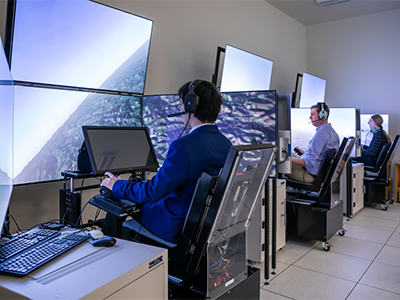Improving the fidelity of our virtual worlds

New starter James Moran is participating in DST’s Research and Innovation Graduate Program. He has just spent eight months helping extend air operations flight simulators, and now has a four-month rotation with a team analysing aircraft capability.
While the air operations simulators have been used at Fishermans Bend for decades, some new modules and advanced capabilities that James has been working on will be used in future experiments to assess more complex warfare activities using distributed simulation. James and colleagues will design test experiments and evaluate the activities.
“The human-in-the-loop simulation testbeds are used to evaluate human-machine interfaces, crewing concepts and environment representation in distributed simulations," says James. "Imagine a standard flight simulator software but much more focused on representing the human-machine interface of the aircraft that the RAAF has in its fleet. It’s been good to use my software skills to develop the simulation testbed so it’s usable in a wider range of activities.”
James completed a Bachelor of Robotics and Computer Science at Swinburne last year, picking up the award for most outstanding undergraduate Swinburne Faculty of Science, Engineering and Technology for 2018. “Apart from the coding, it’s also been good to be able to look at the cockpit, which has a lot of electro-mechanical action going on, and recognize what’s happening under the hood because of my robotics studies.”
Tight-knit simulation centre team
New to the team, James says it’s been enjoyable working with colleagues towards the same goal – improving simulation software to make it more realistic and applicable to a wider range of problems. “It’s comforting to know I’ve got a whole team of experienced scientists and engineers, some of whom have worked in this environment for decades, who obviously know a whole lot more than I do about what’s going on in the system. It’s a fun learning experience every day.”
In his new rotation, James will be investigating how machine learning techniques can be integrated with existing air operation simulation software.
What is the DST Air Operations Simulation Centre (AOSC)?
The AOSC is a re-configurable military air operation simulator, located at DST Fishermans Bend. It was developed as a re-usable simulation laboratory where human operators are immersed into simulation environments to conduct experiments related to military air operations. The simulation team works with human factors colleagues, ADF aircrew and other subject matter experts across DST to design scenarios and human-in-the-loop experiments that answer questions of interest.
A wide range of simulation systems are then reconfigured as required to generate an appropriate synthetic environment. AOSC systems include fast-jet and helicopter cockpits, large field-of-view display devices, helmet mounted displays and some of the most sophisticated computer generated forces packages available. The AOSC has been developed with interoperability in mind and has multiple computer networks enabling connection with RAAF and coalition partners to study distributed mission training and aspects of combining Live, Virtual and Constructive (LVC) simulations.

